If you have ever lived in a house where some radiators get scorching hot and others are barley warm or the radiator in the furthest back bedroom takes and absolute age to heat up then this is a sign that your heating system needs balancing.
In this guide we run through the method of balancing radiators and central heating systems to ensure all radiators het at the same rate and to the same temperature.
Why do Radiators Need Balancing?
With some central heating systems, occasionally one or more radiators get quite a bit warmer than others within the system. When this happens it usually means that your central heating system is out of balance.
With an out of balance heating system you will also find that some radiators get hotter much quicker than others.
In some instances, radiators can be different temperatures due to the distance the water that heats them has to travel from the boiler or pump. If your heating system is not balanced then the radiators that are closest to the boiler or heating source may get a lot more hot water than those that are further away.
To be absolutely sure of even temperature distribution around the whole central heating system in your home you will need to take a temperature measurement at the flow side (manual valve/TRV) first, then at the Lockshield side of each radiator.
Once you have done this then you will be able to see the difference in temperature between the 2 flow and return sides of a given radiator and adjust the valves accordingly to get the required temperatures for each side and create a balanced system. More on this below.
The best tool to use to take these measurements are special thermometers which clip onto the radiators pipes and measure the difference in temperature between them. The proper name for radiator thermometers is Differential Thermometers and in the digital age these have become so advanced that the temperature of both the incoming and outgoing radiator pipes can be measured, at the same time, with one thermometer.
These radiator thermometers can be bought from most plumber’s merchants or online and have clamps, or springs attached to enable them to be clipped to the radiator valve pipes.
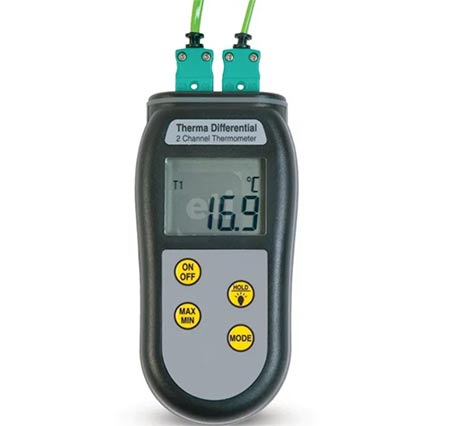
Differential thermometer for measuring temperature of radiators
Will Bleeding Radiators Help?
If you have air in your heating system, inevitably it will find it’s way into one or more of your radiators. Once this happens you will get cold spots and even entire areas on a radiator that won’t heat up (normally at the top) as the present air is preventing hot water from correctly flowing.
When balancing a heating system you want the maximum flow of hot water around your radiators and if air is present and preventing this then you will need to bleed your radiators to remove it before even attempting to balance them.
To bleed a radiator, slowing open the bleed valve at the top (either side is fine) and wait for the air to flow out and water start to flow. For a full guide on how to bleed your radiators see our project here.
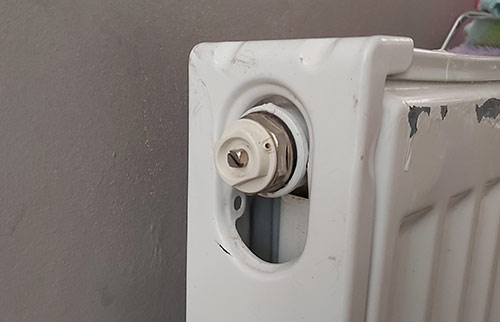
Bleed screw on side of radiator
Types of Heating System
When it comes to types of radiator supply there are essentially 2 different types; The single pipe central heating system and the 2 pipe central heating system.
Single Pipe Central Heating System
With the single pipe heating system, a single pipe runs from your boiler to your radiators and then back to the boiler again.
When the hot pipe gets to a radiator a small branch or tail as they are called is taken and connected to both the flow/feed and return side of the radiator.
As water flows from the boiler it flows up the feed/flow pipe, through the radiator and then out of the return pipe and back into the hot pipe back to the boiler, mixing with the other hot water.
This type of setup is rather dated now due to the fact that it’s quite inefficient and has now been replaced by the more modern and efficient 2 pipe system.
Due to it’s inefficiency, for it to work correctly it needs to be perfectly balanced as if it’s not then you’ll find the first radiator is boiling and others will get colder the further away they are from the heat source.
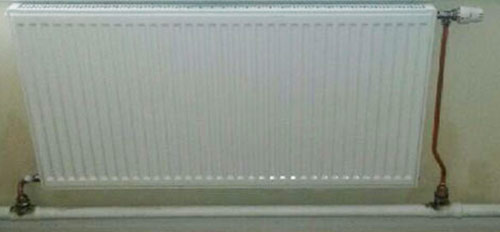
Single pipe radiator system
2-Pipe Central Heating System
With the modern 2 pipe system you have 2 separate pipes running from the boiler to each radiator. One is the flow or feed e.g. takes hot water from the boiler out to the radiators and the other is the return that takes the water away from the radiator and back to the boiler for re-heating.
As the cold water from the radiator is not mixing and cooling the hot water from the boiler as it would with a single pipe system, it’s much more efficient, however to ensure it operates at full efficiency it still need to be balanced.
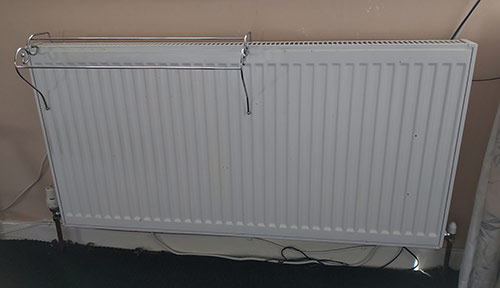
2-pipe radiator and heating system
Types of Radiator Valve
Regardless of the type of heating system you have every radiator will have 2 valves of some type, one on the inlet or flow and one on the outlet or return.
When it comes to balancing radiators and your heating system, the valves are the key as to balance the system you need to control the flow to and from each radiator and ensure they are all the same and this is achieved through adjusting the volume of flowing water.
Before making any adjustments to any valves it’s important to know that different valves there are and how they are adjusted.
Lockshield Valve
The lockshield valve is the one that looks like it has a domed cap over it. To remove the cap, simply use a pair of pliers or grips to grip it and pull it upwards and off. occasionally there may be a small screw through the top holding it in place that will need removing before the cap can be pulled off.
Once the cap has been removed you will then see a small slotted screw cap. You can then use a flat head screwdriver or pair of pliers to turn this valve on and off.
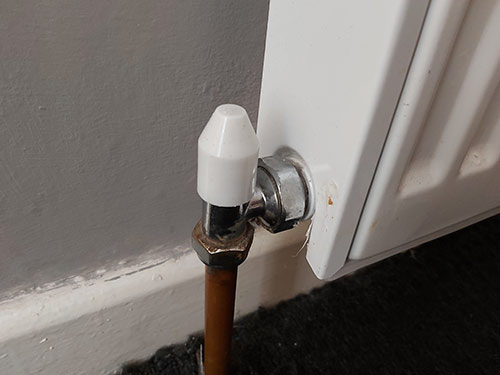
Lockshield valve on radiator
TRV (thermostatic radiator valve)
The TRV is a fairly modern innovation and pretty much all modern heating systems will feature a TRV on every radiator. They are essentially a way to micro-manage the supply of hot water to each radiator.
As you may have guessed, each TRV has it’s own in-built thermostat. Depending on what the thermostat is set to (it’s set by turning the numbered dial to the desired temperature setting), once the ambient temperature in the room reaches this level, the TRV will control the flow of hot water to the radiator, reducing it and saving you energy and money.
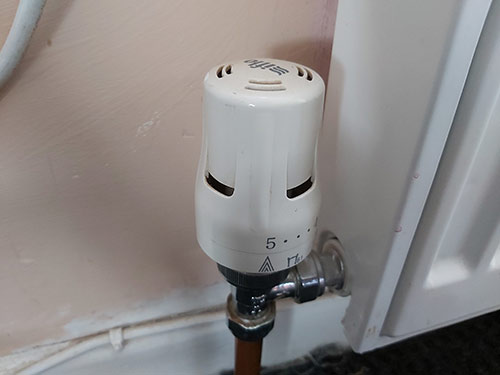
Termostatic radiator valve on radiator
Manual Valve
The manual radiator valve features in place of a TRV when they are not required. In essence it’s just tap that can be used to turn the radiator on and off. They come in several different designs and types but essentially they all do exactly the same thing.
When a manual valve is fitted in place of a TRV the heating control to all of your radiators is achieved through your room thermostat and depending on where this is placed will set the efficiency of your heating system as a whole.
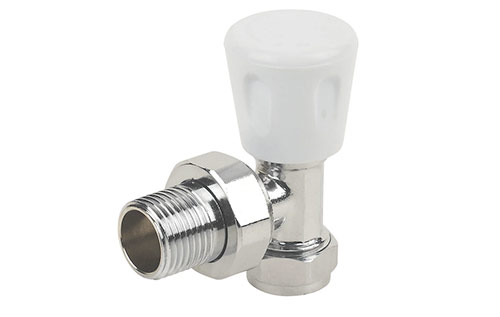
Manual radiator valve
How to Balance a Heating System and Radiators
The next task, now that we you know what different heating systems and valves there are, is to actually get started and balance your heating system.
1. Draw a Heating System and Radiator Plan
As we are going to be individually balancing each radiator and recording temperatures the first job to do is to draw a very rough plan of your heating system and radiators so that you can then mark which heat up the fastest and what temperature each gets to.
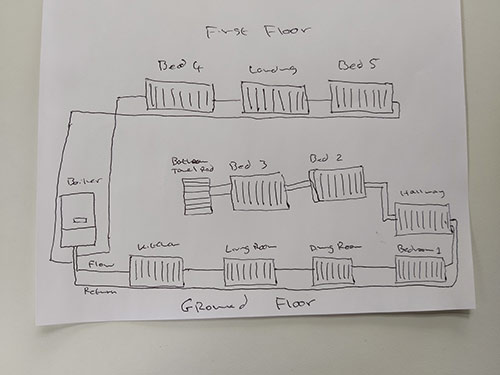
Rough plan of heating system
2. Turn Your Heating System off
To balance your central heating system, first turn off your heating system and allow all radiators to cool down.
Your can’t balance your system when it’s hot or even warn so ensure everything is stone cold before you start.
To do this you can either turn your boiler off or turn the heating off at the heating control unit (normally in your hallway next to the thermostat).
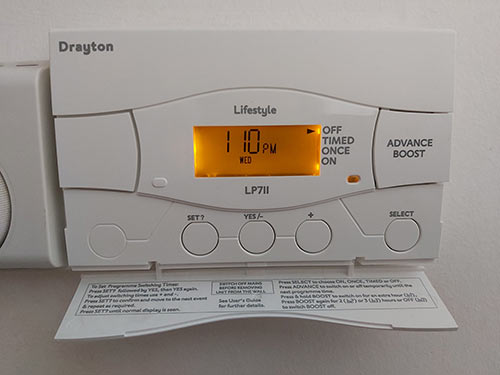
Heating system turned off
3. Bleed Unwanted Air From Radiators
The first job to do is to go around all of your radiators and bleed them to ensure that there is absolutely no air in your heating system that could effect it as you balance the system.
Work your way around each radiator ensuring there is a clean flow of water.
Note: Before bleeding anything ensure your heating system is off and all radiators are cold.
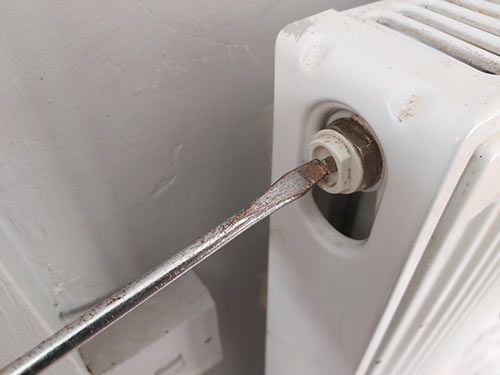
Bleed any air from your radiators
4. Open all Valves on all Radiators
Next, open both of the valves for all of the radiators in your heating system. Ensure that each valve is fully opened to its maximum. This will mean turning each one anti-clockwise.
This is fairly easy for both manual and TRV valves as there is a nice knob or cap to turn, but with locksheild valves you will need to use a flat head screwdriver (for slotted tops), pair of pliers or small adjustable spanner.
Once all the valves have been opened turn your heating system back on and allow it to warm up.
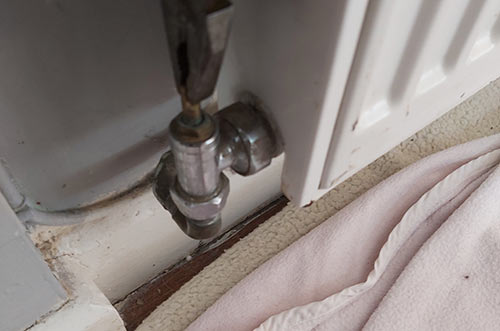
Open all radiator valves
5. Find the Fastest Heating Radiator
With the heating now fully on and your rough plan to hand, walk around your whole home, checking each radiator as you go and identify the one the heats up the fastest. In most cases, but not all, this will be the one closest to the boiler. Mark the first one on your rough plan with the number 1.
To check them all you may need some help so ask a family member or friend for assistance. As they heat up you will also have to work out what order they heat up in. Note this order down on your rough plan as a numbered system rom 1 e.g. 2, 3, 4, 5 etc.
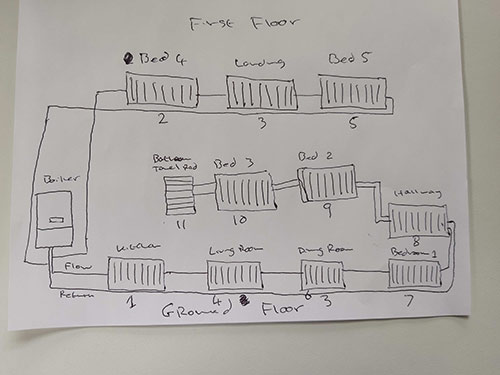
Order of radiators heating up marked on plan
6. Turn Heating off and Allow to Cool
Once you have marked down the heating order of all your radiators you then need to turn off your heating system and allow it to fully cool down.
Go around your house and touch all of your radiators and ensure they are completely cold.
7. Turn off Lockshield Valve and Take Temperatures
Starting with the radiator that heated up first, turn the lockshield valve fully to the right or clockwise to completely turn it off and then turn it back on by only a quarter to a third of a turn.
Once you have done this turn your heating system back on again and allow everything to heat back up to temperature.
Now comes the trickiest part! Use a thermometer to take a temperature reading of the pipework right next to the lockshield valve and then note this on your plan next to the correct radiator and valve location.
Next take a temperature reading of the pipework that leads to your manual or TRV valve, right next to the valve and note this down.
Working very slowly, turn up the lockshield valve, with your thermometer still on the pipe running to the manual/TRV valve, until the difference between both temperature readings is about 11°C or that stated by the manufacturer.
If you are lucky enough to have a differential thermometer then you can do the above at the same time as this type of thermometer can measure the temperature across both locations at the same time.
Once you have achieved this your first radiator has now been balanced so all you now need to do is repeat this for your remaining radiators and you will then have a fully balanced system.
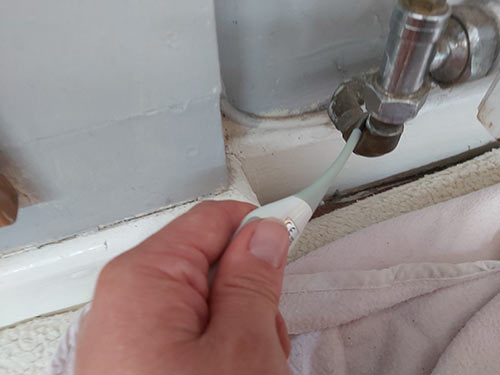
Using a thermometer to check the temperature of locksheild pipe
Balancing a Single Pipe Heating System
Unfortunately balancing an older single pipe heating system is very difficult!
It’s done roughly in the same manner as a 2 pipe system in that, first all the radiators should be bled of any air to prevent cold spots and areas causing issues, e.g. work thorough steps 1 – 3 above.
When you reach step 4 you still open up all lockshields and valves (you may have a lockshield and wheelhead valve as opposed to a manual valve, this type of valve is basically a tap) turn your system back on to heat it up.
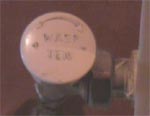
Wheelhead radiator valve
Instead of finding the fastest heating radiator as you do in step 5 you need to identify the radiator at the end of the loop e.g. the last radiator to get water, balance this and then work your way back to the first radiator. This has to be done for each loop.
When we say each loop we mean the upstairs heating circuit and the downstairs heating circuit and each has to be done independently to the other.
Additionally as opposed to trying to exactly match temperatures using a thermometer, which will be nearly impossible as the pipe is constantly having hot water form the boiler and colder water from passing through a radiator run through it, it’s constantly changing.
Instead it’s best to try and do it through feel. Use your hand to feel the pipework and radiators and get them as close as possible.
As you can see form the above, it can be a total nightmare to balance this type of system so if you decide to get the pros in to do it, that may be the better route to take.
Ongoing Heating System Maintenance
Now that you have fully balanced your heating system and it is working at peak efficiency it’s best to keep it this way.
In order to do so it’s well worth checking your radiator temperatures every other month, or sooner if you can, especially during the colder months of the year when you heating system is likely to be on pretty much all the time.
As you now know how to balance your system after a few more goes you’ll refine the technique and you’ll be able to do it in no time.
Additionally if you have to do any work on your heating system such as remove any radiators, replace a radiator, replace your boiler, add inhibitor or other additives or anything similar to this then you will once again need to balance your heating system.
To understand fully how your radiators work, go to our Central Heating – One & Two pipe systems project and our other central heating projects.
If there are radiators on the system which will not balance properly they may need to be removed and flushed out or the system may need to be drained down and cleaned – see our projects on these topics.

